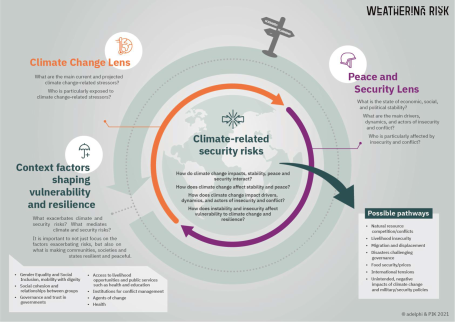The Weathering Risk methodology
Download the full report here.
Climate change reverses progress towards sustainable development and peace, posing risks to human security and making peace harder to achieve. Both slow onset changes such as temperature rise, ocean acidification and changes in precipitation patterns, as well as fast onset events such as storms and floods can have an effect on economic and political security, and on the security of a particular community’s food, health and environment.
Policy- and decision-makers in multiple sectors, especially development, diplomacy and defence, have sought ways to predict and respond to these impacts. However, in order to do so effectively and sustainably, the complexity of different factors and interactions has to be unpacked into a granular understanding of the relationship between environmental change and insecurity in a given context. For awareness of the risks to be converted into action that improves lives, concrete entry points need to be identified.
This is where the Weathering Risk methodology comes in.

Developed by adelphi and the Potsdam Institute for Climate Impact Research and supported by partners such as Chatham House, CGIAR, The Economist Intelligence Unit, Institute for Security Studies, Igarapé Institute, UNDP, UNEP, United Nations University and The World Bank, the Weathering Risk methodology provides a framework for our own assessments, while also offering others a flexible toolkit that can be applied across different scales and degrees of complexity.
The Weathering Risk approach consists of five steps:
- Step 1: Map the impacts of climate change
Climate data and modelling from the Potsdam Institute for Climate Impact Research (PIK), the Weathering Risk co-lead, give a comprehensive and consistent picture of the world under different climate change scenarios. These are converted into projections of how different greenhouse gas emissions scenarios would affect things like crop yield, sea level rise, heat related mortality, storms, flooding, droughts and heatwaves in a particular context.
- Step 2: Analyse vulnerability and resilience
Climate change impact data is combined with a socio-political analysis of the context that includes dimensions of resilience across different groups and communities. Research is locally led wherever possible, supported by relevant regional partners. A gender-sensitive and intersectional approach ensures that findings are disaggregated by gender, age and identity groups to better understand the heterogeneity of risks and dimensions of resilience across contexts and groups.
- Step 3: Identify and test scenarios
From this analysis, future scenarios are developed and checked with diverse groups of experts. The experts are asked about the plausibility of the various outcomes, and invited to elaborate on further possible developments. Crucially, they also make recommendations on how to prevent or reduce adverse security consequences.
- Step 4: Analyse the data with machine learning
Over time, we want to refine and verify our understanding of when and how climate-related security risks emerge in certain contexts. To do this, machine learning will be applied to data emerging from the previous steps in order to help build an understanding of which types of direct and indirect climate-related impacts contribute to which types of conflicts and insecurity, and under which circumstances.
- Step 5: Identify responses
Finally, we identify entry points to address context-specific climate-security risks. Learning from locally-informed field research and consultations, we focus on inclusive and integrated responses that build resilience against both climate and conflict risks such as nature-based solutions, sector-neutral or integrated programming. Faced with uncertainty and shifting probabilities of climate-related scenarios and future socio-political developments, the focus is on ‘no regrets’ approaches that minimise potential unintended negative consequences.
Find out more in the Weathering Risk methodology paper.
Share on


